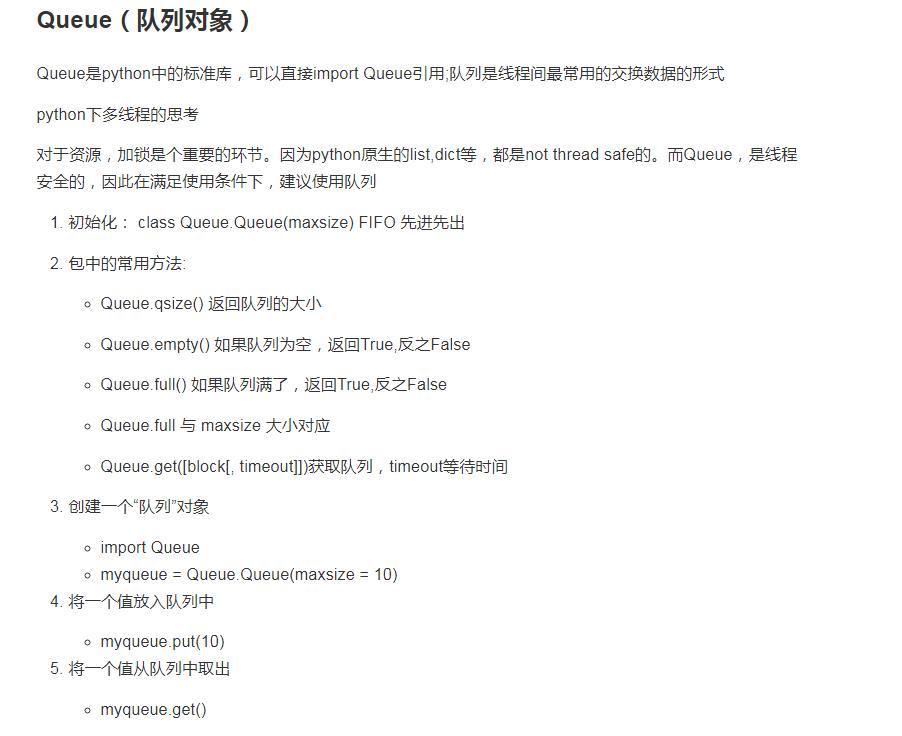多线程爬虫
先回顾前面学过的一些知识
1.一个cpu一次只能执行一个任务,多个cpu同时可以执行多个任务
2.一个cpu一次只能执行一个进程,其它进程处于非运行状态
3.进程里包含的执行单元叫线程,一个进程可以包含多个线程
4.一个进程的内存空间是共享的,每个进程里的线程都可以使用这个共享空间
5.一个线程在使用这个共享空间的时候,其它的线程必须等待(阻塞状态)
6.互斥锁作用就是防止多个线程同时使用这块内存空间,先使用的线程会将空间上锁,其它的线程处于等待状态。等锁开了才能进
7.进程:表示程序的一次执行
8.线程:CPU运算的基本调度单位
9.GIL(全局锁):python里的执行通行证,而且只有一个。拿到通行证的线程就可以进入CPU执行任务。没有GIL的线程就不能执行任务
10.python的多线程适用于大量密集的I/O处理
11.python的多进程适用于大量的密集并行计算

多线程爬取糗事百科
#!/usr/bin/env python # -*- coding:utf-8 -*- # 使用了线程库 import threading # 队列 from Queue import Queue # 解析库 from lxml import etree # 请求处理 import requests # json处理 import json import time class ThreadCrawl(threading.Thread): def __init__(self, threadName, pageQueue, dataQueue): #threading.Thread.__init__(self) # 调用父类初始化方法 super(ThreadCrawl, self).__init__() # 线程名 self.threadName = threadName # 页码队列 self.pageQueue = pageQueue # 数据队列 self.dataQueue = dataQueue # 请求报头 self.headers = {\'User-Agent\':\'Mozilla/5.0 (Windows NT 6.1; Win64; x64) AppleWebKit/537.36 (KHTML, like Gecko) Chrome/60.0.3112.101 Safari/537.36\'} def run(self): print "启动 " + self.threadName while not CRAWL_EXIT: try: # 取出一个数字,先进先出 # 可选参数block,默认值为True #1. 如果对列为空,block为True的话,不会结束,会进入阻塞状态,直到队列有新的数据 #2. 如果队列为空,block为False的话,就弹出一个Queue.empty()异常, page = self.pageQueue.get(False) url = "http://www.qiushibaike.com/8hr/page/" + str(page) +"/" #print url content = requests.get(url, headers = self.headers).text time.sleep(1) self.dataQueue.put(content) #print len(content) except: pass print "结束 " + self.threadName class ThreadParse(threading.Thread): def __init__(self, threadName, dataQueue, filename, lock): super(ThreadParse, self).__init__() # 线程名 self.threadName = threadName # 数据队列 self.dataQueue = dataQueue # 保存解析后数据的文件名 self.filename = filename # 锁 self.lock = lock def run(self): print "启动" + self.threadName while not PARSE_EXIT: try: html = self.dataQueue.get(False) self.parse(html) except: pass print "退出" + self.threadName def parse(self, html): # 解析为HTML DOM html = etree.HTML(html) node_list = html.xpath(\'//div[contains(@id, "qiushi_tag")]\') for node in node_list: # xpath返回的列表,这个列表就这一个参数,用索引方式取出来,用户名 username = node.xpath(\'./div/a/@title\')[0] # 图片连接 image = node.xpath(\'.//div[@class="thumb"]//@src\')#[0] # 取出标签下的内容,段子内容 content = node.xpath(\'.//div[@class="content"]/span\')[0].text # 取出标签里包含的内容,点赞 zan = node.xpath(\'.//i\')[0].text # 评论 comments = node.xpath(\'.//i\')[1].text items = { "username" : username, "image" : image, "content" : content, "zan" : zan, "comments" : comments } # with 后面有两个必须执行的操作:__enter__ 和 _exit__ # 不管里面的操作结果如何,都会执行打开、关闭 # 打开锁、处理内容、释放锁 with self.lock: # 写入存储的解析后的数据 self.filename.write(json.dumps(items, ensure_ascii = False).encode("utf-8") + "\\n") CRAWL_EXIT = False PARSE_EXIT = False def main(): # 页码的队列,表示20个页面 pageQueue = Queue(20) # 放入1~10的数字,先进先出 for i in range(1, 21): pageQueue.put(i) # 采集结果(每页的HTML源码)的数据队列,参数为空表示不限制 dataQueue = Queue() filename = open("duanzi.json", "a") # 创建锁 lock = threading.Lock() # 三个采集线程的名字 crawlList = ["采集线程1号", "采集线程2号", "采集线程3号"] # 存储三个采集线程的列表集合 threadcrawl = [] for threadName in crawlList: thread = ThreadCrawl(threadName, pageQueue, dataQueue) thread.start() threadcrawl.append(thread) # 三个解析线程的名字 parseList = ["解析线程1号","解析线程2号","解析线程3号"] # 存储三个解析线程 threadparse = [] for threadName in parseList: thread = ThreadParse(threadName, dataQueue, filename, lock) thread.start() threadparse.append(thread) # 等待pageQueue队列为空,也就是等待之前的操作执行完毕 while not pageQueue.empty(): pass # 如果pageQueue为空,采集线程退出循环 global CRAWL_EXIT CRAWL_EXIT = True print "pageQueue为空" for thread in threadcrawl: thread.join() print "1" while not dataQueue.empty(): pass global PARSE_EXIT PARSE_EXIT = True for thread in threadparse: thread.join() print "2" with lock: # 关闭文件 filename.close() print "谢谢使用!" if __name__ == "__main__": main()